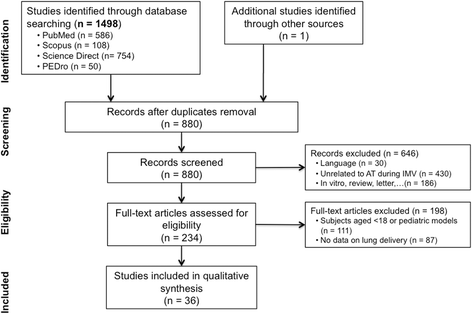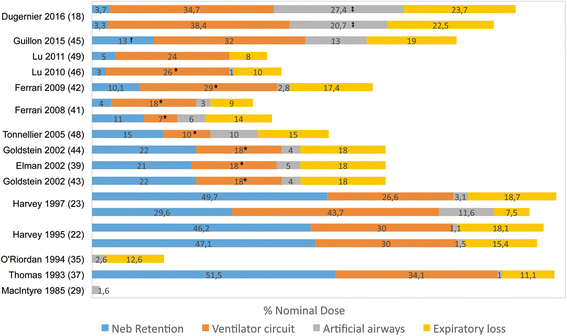Aerosol delivery during invasive mechanical ventilation: a systematic review
- PMID: 29058607
- PMCID: PMC5651640
- DOI: 10.1186/s13054-017-1844-5
Aerosol delivery during invasive mechanical ventilation: a systematic review
Abstract
Background: This systematic review aimed to assess inhaled drug delivery in mechanically ventilated patients or in animal models. Whole lung and regional deposition and the impact of the ventilator circuit, the artificial airways and the administration technique for aerosol delivery were analyzed.
Methods: In vivo studies assessing lung deposition during invasive mechanical ventilation were selected based on a systematic search among four databases. Two investigators independently assessed the eligibility and the risk of bias.
Results: Twenty-six clinical and ten experimental studies were included. Between 30% and 43% of nominal drug dose was lost to the circuit in ventilated patients. Whole lung deposition of up to 16% and 38% of nominal dose (proportion of drug charged in the device) were reported with nebulizers and metered-dose inhalers, respectively. A penetration index inferior to 1 observed in scintigraphic studies indicated major proximal deposition. However, substantial concentrations of antibiotics were measured in the epithelial lining fluid (887 (406-12,819) μg/mL of amikacin) of infected patients and in sub-pleural specimens (e.g., 197 μg/g of amikacin) dissected from infected piglets, suggesting a significant distal deposition. The administration technique varied among studies and may explain a degree of the variability of deposition that was observed.
Conclusions: Lung deposition was lower than 20% of nominal dose delivered with nebulizers and mostly occurred in proximal airways. Further studies are needed to link substantial concentrations of antibiotics in infected pulmonary fluids to pulmonary deposition. The administration technique with nebulizers should be improved in ventilated patients in order to ensure an efficient but safe, feasible and reproducible technique.
Keywords: Antibiotics; Bronchodilators; Nebulizer; Scintigraphy.
Conflict of interest statement
Ethics approval and consent to participate
Not applicable.
Consent for publication
Not applicable.
Competing interests
The authors declare that they have no competing interests. Stephan Ehrmann received research support to his institution from Aerogen Ltd, Fisher & Paykel and Hamilton Medical and consultancies/lecture fees from Aerogen Ltd, La diffusion technique Française.
Publisher’s Note
Springer Nature remains neutral with regard to jurisdictional claims in published maps and institutional affiliations.
Figures



References
Publication types
MeSH terms
Substances
LinkOut - more resources
Full Text Sources
Other Literature Sources

